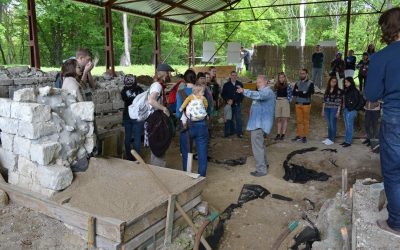POMÁZ-NAGYKOVÁCSI-PUSZTA HERITAGE SITE (POMÁZ, HU)

Pomáz-Nagykovácsi-puszta is a complex archaeological-environmental heritage site situated on the edge of Pomáz, a small town 20 km north from Budapest, close to the Duna-Ipoly National Park and Biosphere Reserve. The site used to be the manorial complex of a nearby Cistercian monastery in the Middle Ages, which was specialized in glass production. Now it displays ruins of the former church and manorial buildings as well as traces of historical land-use and water systems including medieval fishponds. It is in private ownership as part of a bio-goat farm.
Aims:
• Finding a complex, and economically sustainable functionality for the site that promotes the heritage value of the assets, integrates it with the surrounding National Park and helps the sustainability of the farm and the recently established training centre;
• Integrating it regionally and nationally into heritage paths;
• Building co-operation with local institutions using the concepts of local historical heritage;
• Creating a broader community around the site.
Work so far:
• Establishing co-operation with local civic organizations. We had a series of joint events at the site as well as in the town targeting the local community, and volunteers from the organizations contributed to developing more visitor-friendly conditions at the site.
• Starting a co-operation with the town leadership; the Lab is involved in the development of the Helyi Értéktár (Local Values – means local heritage) program.
• Setting up a bilingual website of the Glasshill site (the name we use instead of the official name of the registered archaeological site, Pomáz-Nagykovácsi-puszta): www.glasshill.eu
Challenges ahead:
• State of and access to the ruins: the heritage site is situated on private property closed from visitors, the local community and the tourists. They have been opened for the broader public for the events co-organized with local civic organizations, but a long-term sustainable solution is needed.
• Environmental: the site is located in a natural area under legal protection creating challenges when planning archaeological research and any developments that concern the conservation, management, and presentation of the site.
• Economic: neither the bio-farm, nor the built heritage site or the educational centre is an economically sustainable enterprise alone. There is a need for a sustainable financial model.
• Stakeholder involvement: managing the co-operation of various stakeholders that include the owner of the farm, the National Park, the parties interested in the research and presentation of the built heritage on the site (CEU using it as an educational and training site), local civic organizations, and various segments of the local community.
• Cultural-geographical: the site is marginally situated from the point of view of the town and the local community, both geographically and in terms of their self-perception. The co-operation started with the town leadership and local civic organizations was the first step to reduce this gap.
Contact
József Laszlovszky
Laszlovj@ceu.edu
Dóra Mérai
MeraiD@ceu.edu
Take part in the work:
Visit Lab
To download:
Local Action Plan Pomaz
The Glasshill Foundation was established
One of the most important questions about sustainability is about how to create the necessary governance frameworks for the experimental sites OpenHeritage works with. In case of the...
Working during the pandemic
How the Pomáz Lab adapted to the new circumstances During the pandemic the Pomáz Lab faced an entirely new situation: personal participation became impossible. So how to keep on working and develop...
Local activities to build the Pomáz heritage community
To understand how locals perceive their heritage, what elements they find important and how they relate to the Pomáz-Nagykovácsi site lies at the heart of the Pomaz Lab’s strategy. It is regarded as...



